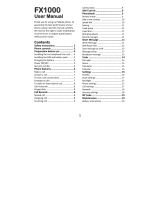
2
Voice command ..................................31
Network ................................................32
Call settings ..........................................32
Quick settings.................................34
Quick settings ......................................34
Accessories settings ............................35
6. Phonebooks ....................36
Introduction ....................................36
Phonebook ......................................37
Phonebook in SIM card ....................37
Phonebook in phone ..........................37
Add names in the phonebook.....37
In the SIM card ...................................37
In the phone ........................................38
Own number .......................................39
Edit and manage names ................39
In the SIM card ...................................39
In the phone ........................................39
7. Calls and messages........42
Introduction ....................................42
Call a number .................................42
Emergency number ............................42
Other number .....................................43
Messages ..........................................43
Send a SMS .........................................44
Read SMS ............................................45
SMS Archive .........................................46
SMS settings ........................................46
Broadcast SMS ...................................47
Call list ...................................................48
Display ..................................................48
Reset ......................................................48
8. Organiser & Extras........49
Introduction ....................................49
Organiser .........................................49
Creating a new event ........................49
Modifying an event ............................50
Views of events ...................................52
Time zone ............................................52
Extras ................................................52
Brick game ...........................................52
Call counters ........................................52
Chinese feature ...................................53
Memory status ....................................54
Calculator .............................................54
Alarm clock ..........................................55
9. E-mail ................................56
Introduction ....................................56
Settings .............................................57
GSM network ......................................57
E-mail server access ..........................57
Advanced ..............................................58
Write and send e-mails.................59
To one or several recipients ............59
With an attachment ..........................60
Receive and read e-mails..............60
Connect to the server ........................60
Download e-mails ...............................61
Get and store attachments ..............61
Add an e-mail address to the
phonebook ............................................62
Delete e-mails .....................................63
Reply to an e-mail ..............................63
Forward an e-mail ..............................63






















